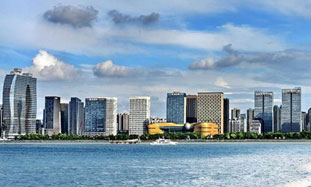Hangzhou 2022 Asian Games stadium nears completion

The Hangzhou Olympic and International Expo Center is set to be the main venue for the 2022 Asian Games, which is to be held in Hangzhou, the capital of East China's Zhejiang province. Construction of the stadium has now entered its final stage. [Photo/zjol.com.cn]
The main venue for the 2022 Asian Games in Hangzhou, Zhejiang province has entered its final stage of construction following the completion of the stadium's interior decoration, Wang Jin, the project's chief engineer, announced in an interview on Feb 9.
The Hangzhou Olympic and International Expo Center should be fully completed within three to four months, according to Wang. The only work remaining now is the installation of equipment such as LED screens and the running track, and final safety tests.
The new stadium will have a total floor area of 229,000 square meters and capacity to seat 80,800 people, making it the second largest arena in China after Beijing's National Stadium, also known as the Bird's Nest. The complex also houses a museum for local intangible cultural heritage and a large exhibition and conference center underneath the stadium.
The arena's striking design, with 55 curved metallic "petals" folded around its bowl-like structure, is designed to represent the city's beautiful waterways and its heritage as a center for China's silk industry.
Standing near the bank of the Qiantang River in downtown Hangzhou, just a stone's throw from the city's world-famous West Lake scenic area, the stadium has become an instant landmark in Hangzhou, with locals dubbing it the "white lotus".
"The stadium is like art solidified," said one local resident.
The stadium has also been praised for its efficient usage of materials, with the China Construction Metal Structure Association naming the project China's best steel-based design. Building the entire complex required just 26,000 tons of steel, half the amount used in the construction of the Bird's Nest in Beijing.
The "white lotus" is expected to be equally popular with athletes, as it includes a number of facilities designed to bring them more convenience, including a 3,000-square-meter warm-up space and a 60-meter-long practice track.
Residents will be able to visit the stadium for free on days when no events are scheduled, and they will also enjoy free access to the complex's local intangible cultural heritage protection center and expo center, with the complex designed to be a destination for sports, culture, entertainment and travel.
Standing on the arena's 7.6-meter-high sightseeing platform, visitors will be treated to splendid views along the Qiantang River, while the stadium will provide a magnificent sight for people on the other side of the river, particularly after dark when it is illuminated by a multitude of colored floodlights.
The inside of the stadium is equally colorful, with its seats gradually changing in color from red to purple, grey, light and dark blue.

 Print
Print Mail
Mail
 20 Cultural Symbols
20 Cultural Symbols Why Zhejiang
Why Zhejiang Experiencing high-tech products at WIC
Experiencing high-tech products at WIC Zhejiang Release
Zhejiang Release Zhejiang News
Zhejiang News